
- Home
- Photography Tours
- Diary / Blog
- Galleries
- Foreign Trips
- Tasmania 2016
- NE Queensland 2016
- Western Alps 2016
- NE Spain 2016
- Australia's Wet Tropics 2015
- Australia's Top End 2015
- SW Australia 2015
- Switzerland 2015
- Andalucia 2015
- Belize 2015
- Australia 2014
- Switzerland 2014
- Belize 2014
- Bahama Islands 2014
- Switzerland 2013
- Ecuador 2012-2013
- Florida 2011-2012
- Vancouver Island 2011
- Australia 2010
- Peru 2008
- Bulgaria 2007
- Lesvos 2006
- California 2006
- New Zealand 2005
- Extremadura 2005
- Goa, India 2004
- The Gambia 2003
- About
July 2014
25th July 2014
Colony-reared Tsetse Flies & Kissing Bugs
A very good friend of mine just happens to be in charge of one of the few Tsetse fly colonies in Europe, and since she had recently pointed out that I have a few gaps in my portfolio of the life-cycle of the Tsetse fly, I decided to take my macro gear with me on my latest visit and see what I could do about getting the shots I needed.
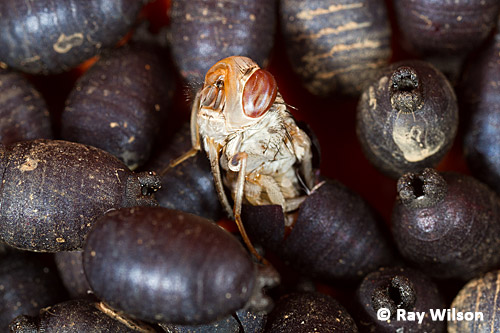
Tsetse Fly (Glossina morsitans) emerging from its puparium
The hardest shot to get, and the one that took the most time to achieve, was to capture the instant the adult flies break out of their puparium. This event takes place very quickly and from the moment the puparium starts twitching to the fly scuttling away from the empty shell is at most 5 seconds, and is often over a lot quicker! Since they are quite small at this stage of their life cycle (see photo of newly emerged, spider-form fly resting on the little finger of my friend to see just how small they are...), I was using my high-powered macro lens (Canon MP-E 65mm macro): a totally manual lens which is not one of the easiest of lenses to get into focus quickly when you have it zoomed to above 2x-lifesize.
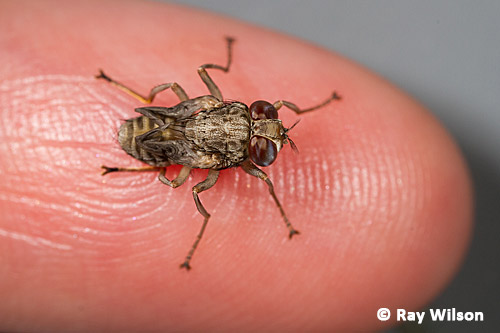
newly-emerged, spider-form of Tsetse Fly (Glossina morsitans) resting on my friend's pinky
Newly-emerged Tsetse flies are often known as spider-forms due to their movements being reminiscent of a running spider.
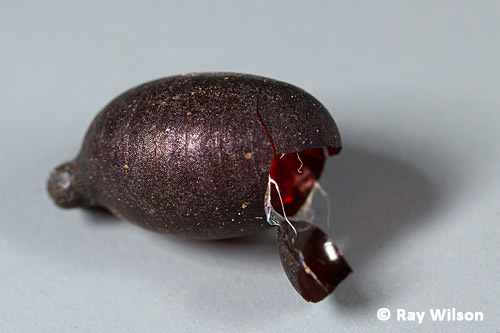
Empty puparium of Tsetse Fly (Glossina morsitans) showing the hole from which the adult fly broke out
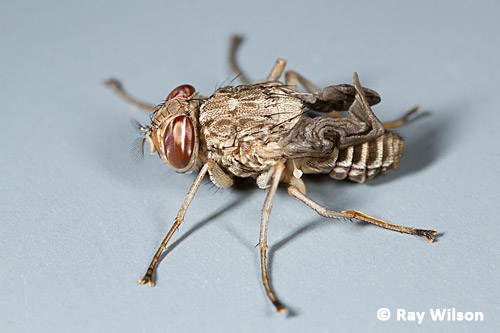
newly-emerged, spider-form of Tsetse Fly (Glossina morsitans)
They are very vulnerable at this stage of their life-cycle and immediately after eclosion the spider-form fly begins to pump air into its body to inflate both its wings and body, almost doubling its size in about 10-15 minutes! This process needs to be completed while their exoskeleton is still soft. Once the exoskeleton hardens, changing its body size becomes impossible.
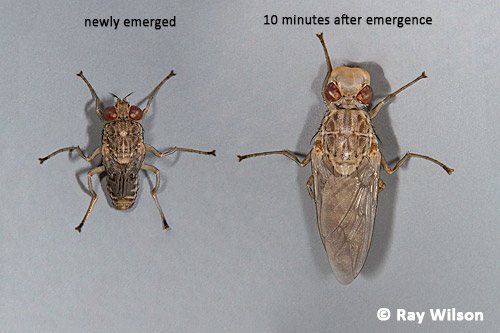
Size comparison of Tsetse Flies (Glossina morsitans) immediately after eclosion and 10 minutes after eclosion
During the inflation process the head takes on a swollen, balloon-like appearance, forcing its antennae to the underside of its head.
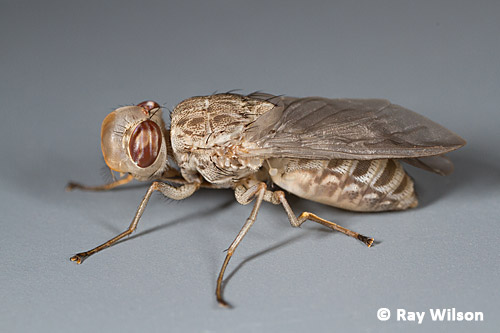
"Torpedo-form" of Tsetse Fly (Glossina morsitans) in the process of pumping air into its wings
Teneral flies at this stage are sometimes known as the "torpedo-form" due to their pointed abdomens and neckless appearance.
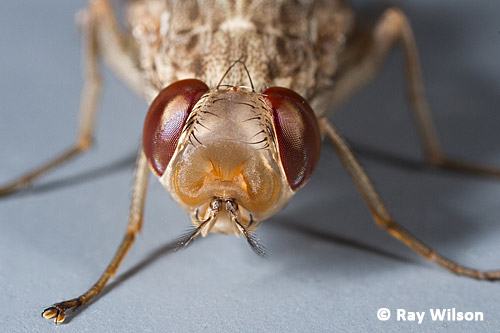
Close-up of head of the "Torpedo-form" of Tsetse Fly (Glossina morsitans) showing its massively inflated ptilinum
The wings of teneral flies are partially opaque with a pearly colour and it is not until they are fully dried and hardened that they attain the transparency of the adult wings.
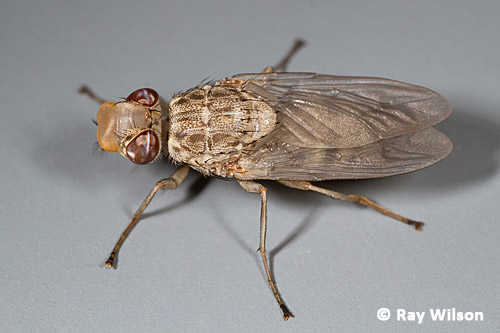
"Torpedo-form" of Tsetse Fly (Glossina morsitans) with fully inflated wings
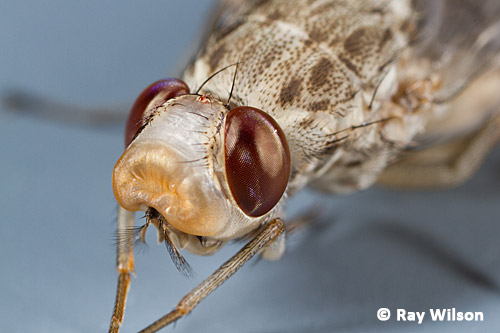
Close-up of head of the "Torpedo-form" of Tsetse Fly (Glossina morsitans) showing its massively inflated ptilinum
Once the fly has inflated itself completely the ptilinum deflates, usually popping back into shape very quickly, although it can sometimes take a few minutes, as was the case with the female below.
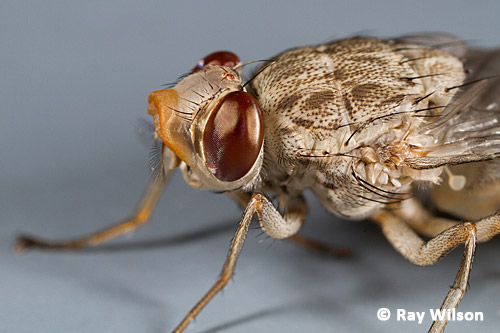
As the ptilinum deflates the antennae begin to migrate up the face to their normal position
As the ptilinum deflates the head begins to take on its normal adult shape, with the antennae migrating back up the face and the maxillary palps, which form a fused sheaf that protects the proboscis, swing up to the normal forward-pointing position that is characteristic of the adult flies.
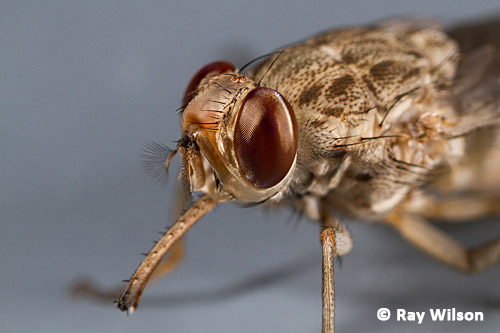
Once the ptilinum is almost completely deflated the proboscis swings into its normal, forward-pointing position
About 15 minutes after breaking out of its puparium the fly is ready for its maiden flight.
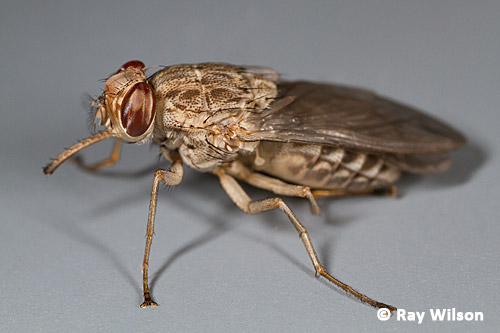
Adult female approximately 15 min after eclosion
I also took the opportunity to photograph the Rhodnius they had just received from another friend of mine at Swansea.
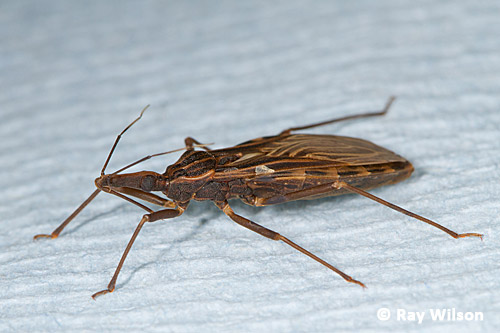
Adult Rhodnius prolixus
These are the second most important vector of Chagas' Disease in South and Central America and are known colloquially as "kissing bugs" due to their propensity to bite their victims on the face.
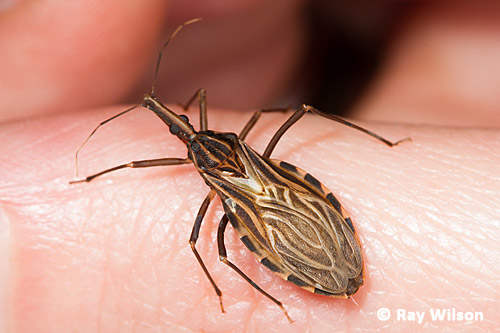
Adult Rhodnius prolixus
Unlike Tsetse flies, who inject Trypanosomes directly into the wound in their saliva, disease transmission by Rhodnius and other Triatomid bugs is through their fecal material, and the Trypanosomes enter the wound when the bitten person rubs the itchy bite site. The disease can also occasionally be contracted through the ingestion of food contaminated with Rhodnius faeces.
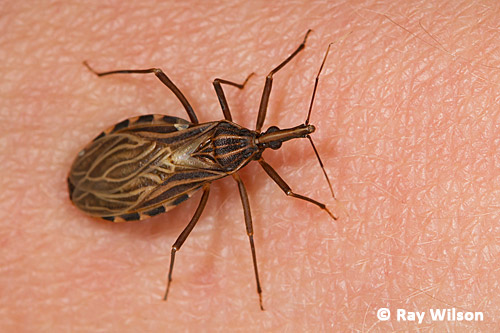
Adult Rhodnius prolixus
Ray Wilson owns the copyright of all images on this site.
They may not be used or copied in any form without prior written permission.
raywilsonphotography@googlemail.com